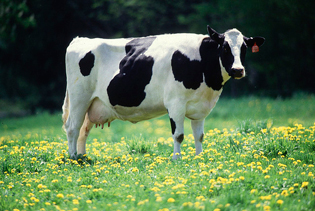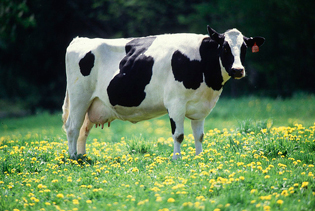 When cows kill. This article was syndicated with permission from OnEarth.
When cows kill. This article was syndicated with permission from OnEarth.
Stuart Levy once kept a flock of chickens on a farm in the rolling countryside west of Boston. No ordinary farmer, Levy is a professor of molecular biology and microbiology and of medicine at Tufts University School of Medicine. This was decades ago, and his chickens were taking part in a never-before-conducted study. Half the birds received feed laced with a low dose of antibiotics, which U.S. farmers routinely administer to healthy livestock — not to cure illness, but merely to increase the animals’ rates of growth. The other half of Levy’s flock received drug-free food.
Results started showing up almost instantly. Within two days, the treated animals began excreting feces containing E. coli bacteria that were resistant to tetracycline, the antibiotic in their feed. (E. Coli, most of which are harmless, normally live in the guts of chickens and other warm-blooded animals, including humans.) After three months, the chickens were also excreting bacteria resistant to such potent antibiotics as ampicillin, streptomycin, carbenacillin, and sulfonamides. Even though Levy had added only tetracycline to the feed, his chickens had somehow developed what scientists now call “multi-drug resistance” to a host of antibiotics that play important roles in treating infections in people. More frightening, although none of the members of the farm family tending the flock were taking antibiotics, they, too, soon began excreting drug-resistant strains of E. coli.
When Levy’s study was published in The New England Journal of Medicine in 1976, it was met with skepticism. “The other side — industry — could not believe that this would have happened. The mood at the time was that what happens in animals does not happen in people,” said Levy, who serves as president of the Alliance for the Prudent Use of Antibiotics, in a telephone interview from his office at Tufts. “But we had the data. It was obvious to us even then that using antibiotics this way was an error and should be stopped.”
During the intervening 35 years, study after study has confirmed Levy’s findings and shown that the problem of antibiotic-resistant “superbugs” is even worse than anyone could have imagined. Each year, 70,000 Americans in U.S. hospitals die from bacterial infections that drugs are unable to kill. And even as the number of infectious diseases is on the rise, more antibiotics are administered to livestock than ever before, from 17.8 million pounds per year in 1999 according to the Animal Health Institute (a trade organization of companies, like Bayer, Novartis, and Pfizer, that manufacture livestock drugs) to 29.8 million pounds in 2009, according to the U.S. Food and Drug Administration (FDA). Fully 80 percent of the antibiotics used in the United States are given to livestock, and the vast majority are administered to promote growth and stave off potential infections, not to treat illness.
From his perspective of more than three decades as a resistant-microbe watcher, Levy sounded almost weary when he said, “Proponents of growth promotion keep asking for more data, and we scientists provide them. But then the findings have never led to removal of the practice.”
Getting serious
Last month, the Natural Resources Defense Council, Center for Science in the Public Interest, Food Animal Concerns Trust, Public Citizen, and the Union of Concerned Scientists joined forces to file a lawsuit against the FDA. The groups want the agency to withdraw its approval for most non-therapeutic uses of penicillin and tetracycline in animal feed. They say that it’s something regulators should have done decades ago.
The FDA first approved the use of low-dose antibiotics in the 1950s. Concerns about the drugs began appearing within a decade, and by the time Levy’s paper was published, the FDA was aware the practice posed a serious risk to human health. The agency proposed to withdraw its approval in 1977, saying that new evidence showed that penicillin- and tetracycline-containing products had not been “shown safe for widespread, sub-therapeutic use.”
The proposal drew howls of outrage from two of the most powerful lobbying groups in Washington, agribusinesses and drug manufacturers. Both the House and Senate ordered the FDA to “hold in abeyance any and all implementation of the proposal” until further studies had been conducted. “It was the power of the lobby and the money behind that lobby,” Levy recalled.
As requested by Congress, the FDA commissioned three studies during the 1980s, all of which supported initial concerns about the risks of feeding farm animals antibiotics on a daily basis. The FDA received petitions urging it to act from coalitions of scientific and environmental groups in 1999 and 2005. Such respected bodies as the American Academy of Pediatrics, the Centers for Disease Control and Prevention, the National Academy of Sciences, the U.S. Department of Agriculture, and the World Health Organization all identified low-dose antibiotics as the reason antibiotic-resistant bacteria were proliferating in humans and animals. And the FDA — which is charged with protecting the health of Americans — failed to act, only going so far as to issue a “Draft Guidance” [PDF] report and a draft “Action Plan” proposing voluntary guidelines. These suggestions have done nothing to stem the deluge of unnecessary antibiotics through the spigot of agribusiness.
“We’ve been fighting the non-therapeutic use of antibiotics in livestock for more than 30 years,” Margaret Mellon, director of the food and environment program at the Union of Concerned Scientists, said in a press release announcing the lawsuit. “And over those decades the problem has steadily worsened. We hope this lawsuit will finally compel the FDA to act with an urgency commensurate with the magnitude of the problem.” (Siobhan Delancey, a spokeswoman for the FDA, declined to comment on the suit.)
The trouble with antibiotics
Bacteria are evolutionary dynamos. Untold trillions of them can live in one confined animal feeding operation, or CAFO — the technical term for a factory farm. They breed rapidly and mutate readily. Exposure to even miniscule levels of drugs equips bacteria with the genetic resilience to fend off higher levels of the same drugs.
From the dawn of modern antibiotics, researchers have been aware that the seeds of the wonder drugs’ destruction had already been sown. In his 1945 Nobel acceptance speech for his discoveries related to penicillin, Sir Alexander Fleming said, “There is a danger that the ignorant man may easily under-dose himself and by exposing his microbes to non-lethal quantities of the drug make them resistant.” Fleming’s prediction was prescient — except the problem wasn’t an “ignorant man” but politicians and business executives whose priorities lay elsewhere.
During the decades that the FDA dithered, a mountain of scientific research accumulated showing that antibiotic-resistant bacteria can not only evolve in the guts of farm animals, but can spread from animals to the humans who tend them, and then be passed on to people who have never been anywhere near a chicken house or hog barn.
In 2004, Dutch doctors discovered a strain of methicillin-resistant Staphylococcus aureus (MRSA) in a 6-month-old baby. Often fatal, MRSA is the original “superbug” because it can survive treatment by the most powerful antibiotics in modern medicine’s arsenal. At first, the doctors were puzzled. MRSA was primarily known as a hospital-acquired infection. But the child, who carried the germs but never became sick, as is often the case with the asymptomatic carriers of bacteria, had never been in a hospital. Her parents were pig farmers, and subsequent investigations showed that the MRSA had been passed from the pigs to the parents and on to the baby. (Most bacteria are non-infectious, although they may carry resistance genes. The problem is that they can pass their resistance traits to infectious bacteria.)
Three years later, J. Scott Weese, a professor at the Ontario Veterinary College at the University of Guelph near Toronto, found an identical strain of MRSA in Canadian pigs and their owners. The superbug had somehow leapt over the Atlantic Ocean. Further research by Weese revealed that the swapping of resistant bacteria between animals and humans can be a two-way street. Not only were the farmers affected by MRSA that had originated in pigs, but the pigs carried MRSA that until then had only been found in humans.
For a year or so, American agribusiness continued to claim that MRSA was a problem that couldn’t happen here — a myth they were able to perpetrate because no government agency was routinely testing hogs for MRSA. But during the summer of 2008, Tara Smith, a microbiologist at the University of Iowa and the deputy director of the university’s Center for Emerging Infectious Diseases, found that seven out of 10 pigs she and her students tested on farms in Illinois and Iowa carried MRSA.
A graduate student working with Smith recently uncovered a strain of S. aureus associated with hogs and the people who tend them in a day-care worker who had never been near a hog farm. Fortunately, that particular strain was not antibiotic resistant. But the discovery showed that humans do not have to work with infected animals to pick up the bacteria they carry. “Whether the pig bacterium was passed on via another human or via contaminated food products, we can’t tell right now,” Smith said in an email.
Making the case
In fact, there are any number of ways antibiotic-resistant bacteria can spread from farm to fork. A recently published study in the journal Clinical Infectious Diseases found that 47 percent of the beef, chicken, pork, and turkey sampled from grocery stores in five U.S. cities carried drug-resistant S. aureus. Superbugs are literally blowing in the wind. According to a 2006 report in the journal Environmental Health Perspectives, multi-drug-resistant bacteria were found in the air downwind of a confined hog operation. Nearly 90 percent of the E. coli in liquid manure pits associated with pig farms are resistant to drugs, according to Kellogg Schwab, the director of the Johns Hopkins Center for Water and Health. Manure ponds frequently burst their banks and contaminate nearby streams, rivers, and wells.
Pharmaceutical companies dispute the assertion that treating animals with low-dose antibiotics is dangerous to humans. “A lot of people want to talk about antibiotic resistance as if it is a big amorphous issue,” said Ron Phillips of the Animal Health Institute, in an interview. “It is, in fact, a series of discrete issues where you have to look at specific bug/drug combinations and figure out what are the potential pathways for antibiotic-resistant material to transfer from animals to humans. Studies have been done, and have come to the conclusion that there is a vanishingly small level of risk.”
Smith of the University of Iowa says that the specific studies that the industry suggests are necessary simply cannot be done — it would be the equivalent of having to have an eyewitness to prosecute any crime. “But we have DNA from the crime scene that matches that of the suspect. At some point you have to accept that he is responsible. The bulk of evidence is overwhelming.”
One area where solid scientific evidence is lacking, astonishingly, is on whether changing the industry-wide practice of giving low doses of antibiotics to livestock would actually make that much of a difference. The experience of farmers in the European Union, where dosing animals with sub-therapeutic levels of antibiotics was banned in 1998, suggests otherwise. Denmark is the world’s largest pork exporting country, and most of its hogs are raised in large confined operations much like those used by the U.S. pork industry. In that country, the overall use of antibiotics fell by 37 percent [PDF] between 1994 and 2009, according to a study by Denmark’s National Food Institute. Correspondingly, levels of resistant bacteria in animals and people plummeted, but production levels of meat either stayed the same or increased: The average daily weight gain per pig was actually higher in 2008 than in 1992 when antibiotics were routinely administered.
It’s easy to understand why drug companies react so forcefully to any attempts to cut back on sub-therapeutic antibiotic use — FDA figures show that 60 percent of the antimicrobial drugs they sell are fed to farm animals to promote growth, an enormous chunk of their business — but given the success of farmers in Europe who’ve stopped using antibiotics to promote growth, why is the farm lobby so vehemently against change? Would it spell the end of the huge CAFOs upon which American agribusiness has come to depend? Steven Roach, the public health program director for the Food Animal Concerns Trust (FACT), one of the plaintiffs in the lawsuit against the FDA, has a straightforward answer to that question: No, CAFOs would not go away. European pig farms are as large as those in the U.S., according to Roach. Some of the E.U.’s chicken operations are even larger than those in this country. (And if American farmers feel uncomfortable with examples from foreign countries, he suggests that they look at Tyson, one of the United States’ largest poultry producers, which had no problems raising chickens without antibiotics in ways that the suit aims to stop.)
“There are two parts of production where there are small economic benefits to using low-dose antibiotics,” Roach said in an interview. “Particularly on young pigs. The challenge for the beef cattle industry is that when you feed a high-corn diet, cattle have some heath problems, and one way they manage that is using the antibiotics in the feed. But even so, some producers are raising them without antibiotics in feedlots now.” Roach said that European farmers have gotten around these problem areas by weaning piglets later. Barns are kept cleaner for all animals. And altering diets allows CAFOs to raise cattle without antibiotics. Of course, says Roach, some farmers simply won’t want to change. He believes they are afraid that if they allow outside forces to impose even small changes, then other changes are bound to come.
After 35 years on the frontlines in the battle to keep antibiotics effective, though, Levy believes there’s cause for optimism. “The mood is now 180 degrees better than it was for getting rid of this practice,” he said. “There are more and more scientists and lay people who are urgently asking for an end to this use of antibiotics.”
It helps that one of those “science people” is also a representative. Louise Slaughter, a Democrat who represents upstate New York, was a microbiologist before going into politics. In 2009, she introduced a bill called the Preservation of Antibiotics for Medical Treatment Act, which calls for the FDA to withdraw its approval of the practice within two years unless there is reasonable certainty that the low-dose antibiotics cause no harm to human health. “We are witnessing a looming public health crisis that is moving from farms to grocery stores to dinner tables around the country,” she said in an email. “As the only microbiologist in Congress, I feel it’s my duty to bring public attention to this.”
Although Slaughter’s bill has yet to pass, it had 127 cosponsors in the last congressional session, more than double its support in the previous Congress. It looks as though even more legislators will sign on this time, and many are hopeful that the combined forces of looming legislation and an active lawsuit will finally lead the FDA to act. “If we don’t address it,” Slaughter continued, “we risk setting ourselves back to the time before antibiotics, when even common infections could kill a person. That’s not any kind of world I want my children and their children to inherit.”



